Jon Fitzgerald Presents the "Classical Guitar from the Renaissance to the Modern 6-String Guitar"
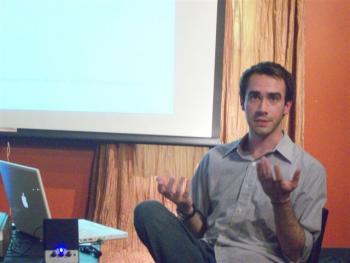
Jon Fitzgerald
Jon Fitzgerald - Eastman doctoral candidate and Cleveland resident - with his associate, Warren Iversen, gave us a fascinating look at the development and progression of guitar-like instruments, composers, and players from 2500 BC through to the 1980’s. We were treated to about thirty hours’ worth of information expertly condensed into about two hours through the use of many drawings, photos, video segments, and live demonstrations with replicas of a vihuela and a theorbo. (guitar predecessors)
The guitar has its roots back to 2500 BC in ancient civilizations like Sumeria, Babylon, Persia, Egypt, and Turkey. Around 200 AD we start to see the “modern” body and sound holes, and around 711 AD the oval body with sound holes was introduced to Spain by the Moors. Around 1400 to 2500 AD other guitar predecessors, along with unique tunings and construction methods, became very popular in Europe.
Some timeline highlights:
I. Ancient ancestors of the guitar (2500 BC - 800 AD)
Queen Shub-Ad’s harp, an artifact unearthed in the early 1900’s from the Sumerian Royal Cemetery at Ur in Iraq.
Around 200 AD we start to see the “modern” body and sound holes, and around 711 AD the oval body with sound holes was introduced to Spain by the Moors.
II. Renaissance (1400 - 1600)
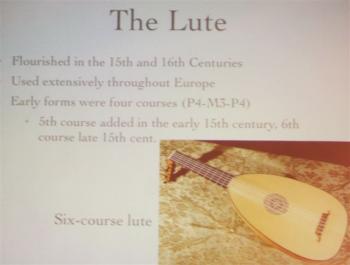
Lute
The vihuela became more popular than the lute. There were three main types, played either with a bow, or a quill, or with the fingers.
Around 1500, the vihuela de mano had six courses of strings and ten moveable gut frets. Jon then showed a video of a vihuela being played outdoors in a garden with a pool and statuary. The piece being played reflected the tranquil setting.
Jon also showed another video segment of Adrian LeRoy playing a piece titled “Fantasy 1.” By the mid to late 1500’s, the early versions of guitars became recognized as being just as capable as other “legitimate” instruments of playing two and three voice compositions; it was not just an “inferior” instrument that many had considered it.
III. Baroque (1600 - 1750)
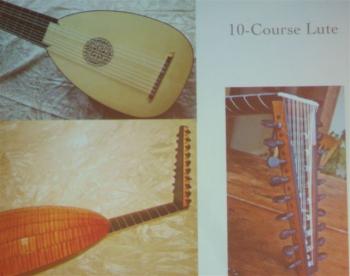
Ten-Course Lute
By this time both players and composers were found in royal courts with accompaniment instruments for singers or small groups. Luthiers showed off their skill by creating rosettes, (also called “roses”) very ornate structures made from parchment and secured in the sound hole. During this period different tunings and tablature methods were developed.
Warren Iversen demonstrated various strumming techniques on a German-made Baroque guitar replica. It was quite loud for such a relatively small-bodied instrument. Jon then showed a video of a Baroque guitar in concert with bass viol, harp, hammered dulcimer, and castanets.
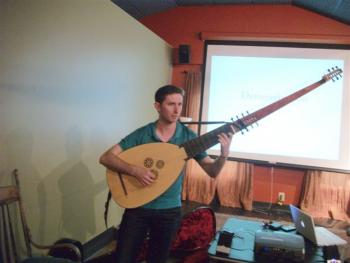
Warren Iversen Plays Theorbo
The theorbo was developed to provide extended bass range by adding a neck extension to lutes, providing open (unfretted) bass strings. Also the top strings were lowered an octave in pitch to avoid conflicting with singers’ voices. Warren Iversen demonstrated his replica theorbo and noted that proper playing technique allows using the “pinky” of the right hand as an anchor point on the soundboard. This allowed more accurate guiding of the hand and the thumb for playing the strings, particularly the open bass strings.
IV. Classical/ Early Romantic (around 1750 - early 1800’s)
By this time the common configuration had become six single strings, rather than double stringing in octaves or unison. Also, fan bracing was developed, which allowed the soundboard to vibrate more freely.
With the decline of the lute in this period, guitar construction developed even more. Some innovations were the modern body shape, two-piece backs, bigger soundholes, machine heads instead of tuning pegs, and bridges with saddles. Luthiers were also experimenting with different bracing methods, (Y shaped, ladder, slanted ladder, etc.) extra strings that would “float” beyond the edge of the neck, or extra strings that all were frettable, or combinations of both. Some luthiers added small levers to the headstocks to allow half-step tuning changes to some strings. One of the attendees suggested they were the precursors to “Scruggs pegs” found on modern banjos!
V. Golden Age (Early 1800’s -> 1830’s)
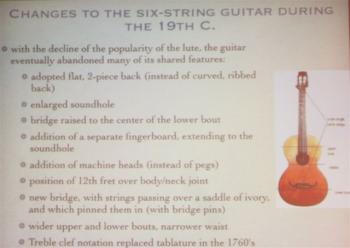
Modern 6-String Guitar
This period, especially in Vienna and Berlin, was characterized as “La Guitarmanie” (Guitarmania). Transcriptions of pieces by classical composers - Beethoven’s “Adelaide”, for example - became as popular for guitar as for piano. Composers like Giuliani in Vienna not only associated with the likes of Beethoven, Schubert, Hummel, Rossini, and Paganini, but they also performed in the top venues of the day!
VI. Late Romantic (2nd half of 19th Century)
This period marked a decline in the guitar’s popularity, it being overshadowed by the piano. However, advances in guitar construction pioneered by Antonio Torres led to louder, more resonant instruments, which in turn paved the way for the rebirth of the guitar in the 20th century. Torres standardized modern guitar design. He demonstrated that the soundboard was the key component of the instrument by making a guitar with sides and back of papier-mâché.
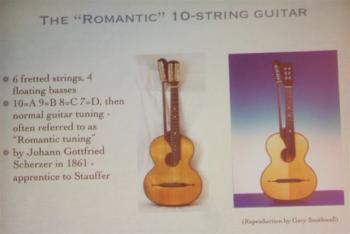
Ten-String Guitar
Francisco Tarrega (1852 - 1909), composer and performer, is credited with raising interest in the guitar as a solo instrument and paving the way for the 20th century emergence of the guitar as a serious concert instrument. He also standardized some playing techniques, such as placing the guitar on the left leg, playing rest strokes with the fingers of the right hand, keeping the “pinky” finger off the soundboard, and using the flesh of the right hand fingers, rather than fingernails to pluck the strings.
Miguel Llobet (1878 – 1938) is considered a primary link between Tarrega and Segovia. He toured extensively throughout the Americas and Europe, increasing the audience for the guitar.
VII. Andres Segovia (Early 1900’s - 1987)
Despite Segovia’s family opposing his becoming a musician, he gave his first concert in Spain at the age of sixteen, with his professional debut at the age of twenty in Madrid. He pioneered the “renaissance” of the guitar as a concert instrument capable of playing “serious” music. Many feel, that without his efforts, the classical guitar would still be considered a lowly instrument played only by peasants.
Segovia expanded the guitar’s repertoire, commissioned works, transcribed lute and vihuela pieces and arranged works by Bach, Handel, Haydn, Mozart, Chopin, and Schumann.
In summary, “you had to be there” to appreciate the detail and quality of the information presented by Jon Fitzgerald and Warren Iversen, and the growing pains builders, players, and composers went through over many centuries to develop and improve the instruments and the music played on them.
~John Williamson
Photos: R. Taglieri
Share this page: ![]() Facebook
Facebook
![]() Del.icio.us
Del.icio.us
![]() StumbleUpon
StumbleUpon
![]() Digg
Digg
![]() Reddit
Reddit
Home ::
About Us ::
Events ::
Articles ::
Resources ::
Contact Us ::
Links
©2007-2012, Rochester Guitar Club, All Rights Reserved, This page last updated 2013-11-13 11:10:18
Website by Red Beagle Web Development.








